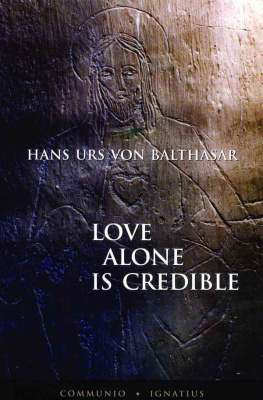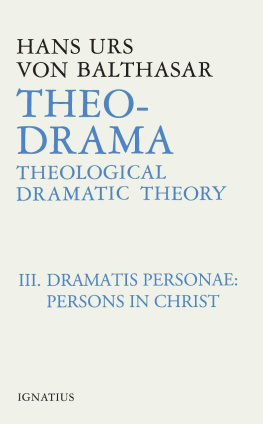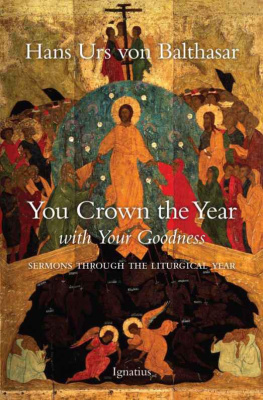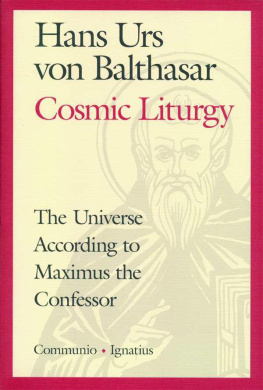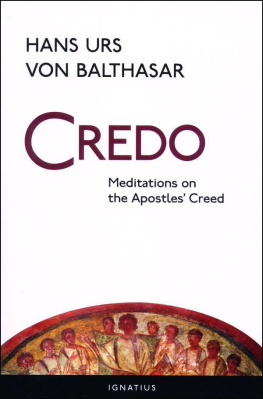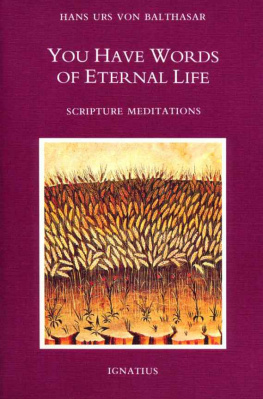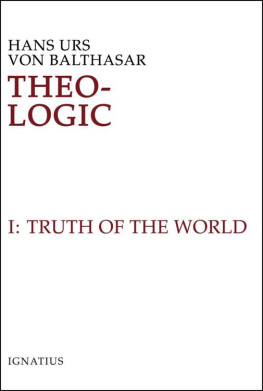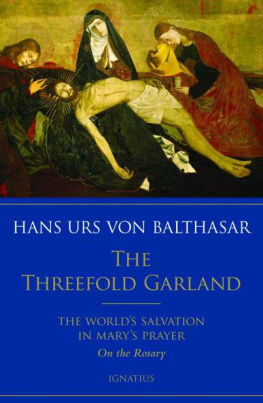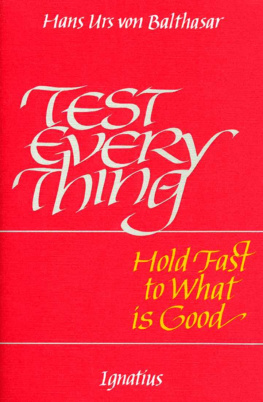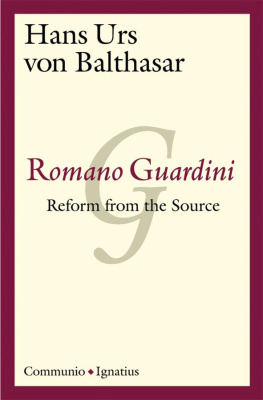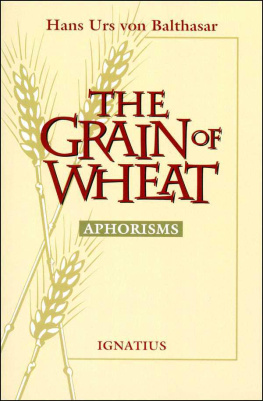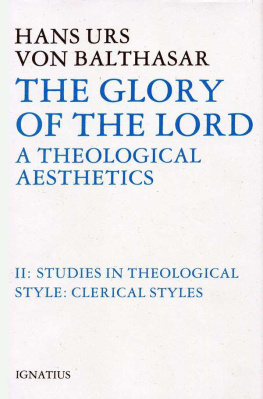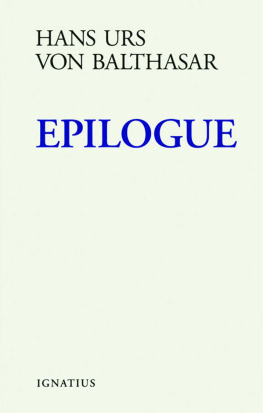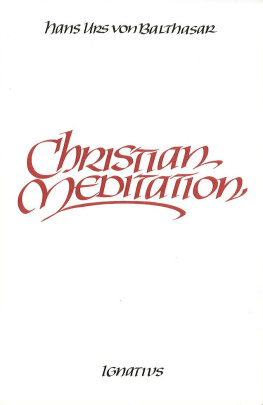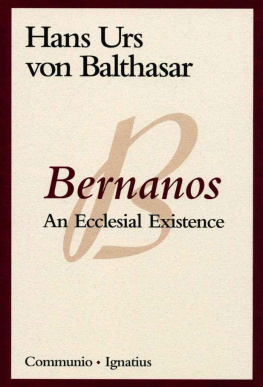LOVE ALONE IS CREDIBLE
HANS URS VON BALTHASAR
LOVE
ALONE
IS
CREDIBLE
Translated by D. C. Schindler
IGNATIUS PRESS SAN FRANCISCO
Original German edition:
Ghubhaft ist nur Liebe
1963 by Johannes Verlag, Einsiedeln
Cover photograph:
Sacred Heart of Jesus
An image scratched on the wall at Auschwitz
photograph by Wieslaw M. Zielinski
Auschwitz, Poland
Cover design by Roxanne Mei Lum
2004 by Ignatius Press, San Francisco
All rights reserved
ISBN 978-0-89870-881-3
Library of Congress Control Number 2003116647
Printed in the United States of America
Quisquis Scripturas divinas vel quamlibet earum partem intellexisse sibi videtur, ita ut in eo intellectu non aedificat istam geminam caritatem, nondum intellexit.-ST. AUGUSTINETout ce qui ne va point la charit est figure.
Lunique objet de lEcriture est la charite.-PASCAL
Contents
Preface
What is specifically Christian about Christianity? Never in the history of the Church have Christian thinkers thought it ultimately adequate to answer this question by pointing to a series of mysteries one is required to believe; instead, they have always aimed at a point of unity that would serve to provide a justification for the demand for faith. They sought a logos that, however particular it might be, nevertheless had the power to persuade, and indeed to overwhelm, a logos that, in breaking out of the sphere of accidental historical truths, would lend these truths a necessity. Miracles and fulfilled prophecies may have their role to play (a role whose significance seems to have diminished considerably after the biblical criticism of the Enlightenment), but they point to something that lies beyond them. The Patristic Age, the Middle Ages, and the Renaissance, with offshoots that extend into the present age, established the reference point within the realm, of the cosmos and world history; after the Enlightenment, the modern age shifted this point to an anthropological center. If the first approach bears the limitations of temporal history, the second also betrays a fundamental flaw, for neither the world as a whole nor man in particular can provide the measure for what God wishes to say to man in Christ; Gods Word is unconditionally theo-logical, or, better, theo-pragmatic: what God wishes to say to man is a deed on his behalf, a deed that interprets itself before man and for his sake (and only therefore to him and in him). What we intend to say about this deed in this book is that it is credible only as lovespecifically, as Gods own love, the manifestation of which is the glory of God.
Christian self-understanding (and therefore theology) can be interpreted neither in terms of a wisdom that surpasses the knowledge of the worlds religions through a divine utterance ( ad majorem gnosim rerum divinamm ) nor in terms of mans definitive achievement of personal and social fulfillment through revelation and redemption ( ad majorem ho minis perfedionem et progressum generis humani ), but solely in terms of the self-glorification of divine love: ad majorem Divini Amoris GLORIAM . In the Old Testament, this glory ( kabod ) is the presence of Yahwehs radiant majesty in his Covenant (and through this Covenant it is communicated to the rest of the world); in the New Testament, this sublime glory presents itself as the love of God that descends to the end of the night of death in Christ. This extremity (the true eschatology)which could never have been anticipated from what we know of the world or mancan be welcomed and perceived in its truth only as the Wholly-Other.
Thus, this sketch will be an elaboration of what I endeavored in my larger work The Glory of the Lord , that is, it will be a theological aesthetic in the twofold sense of a subjective theory of perception and a theory of the objective self-interpretation of the divine glory; it will seek to show that this theological method, far from being a negligible and dispensable by-product of theological thought, cannot but lay claim to the center of theology as the only valid approach, while the approaches founded on the cosmos or world history, on the one hand, or on anthropology, on the other, can be presented as secondary and complementary at best.
What is here called an aesthetic is therefore characterized as something properly theological, namely, as the reception, perceived with the eyes of faith, of the self-interpreting glory of the sovereignly free love of God. This aesthetic has therefore nothing in common with the philosophical aesthetic that one finds, for example, in the Christian thought of the Renaissance (Ficino), or the Enlightenment (Shaftesbury), or German Idealism (Schelling or Fries), or the theology of mediation (de Wette), or even in what Schleiermacher calls aesthetic piety ( The Christian Faith , no. 9). At most, a parallel could be drawn with Schelers phenomenological method, insofar as this method appeals to a pure self-giving of the object; however, in theology the methodological bracketing out of existence falls altogether out of consideration. We cannot strive for a philosophical disinterestedness of pure contemplation ( epoch ? as apatheia for the sake of gnosis ), but only Christian indifferencia as the sole possible methodological disposition for the reception of the disinterestedness of divine love, which has no end beyond itself and is thus absolute.
The present sketch intends only to lay out this central methodological point and will leave aside the whole abundance of content that one may find, for example, in other studies such as Victor Warnachs Agape: Die Liebe ah Grundmotiv der neutestamentlichen Theologie (1951) and C. Spicqs Agape dans le Nouveau Testament (1958-1959), which also contain extensive bibliographies.
It goes without saying that the following essay contains nothing fundamentally new, and that it seeks in particular to stay true to the thought of the great saints of the theological tradition: Augustine, Bernard, Anselm, Ignatius, John of the Cross, Francis de Sales, Thrse of Lisieux.... Lovers are the ones who know most about God; the theologian must listen to them.
The methodological point this essay seeks to develop represents, at the same time, the proper theological kairos of our time: if this approach does not manage to move our age, it has scarcely any chance left of encountering the heart of Christianity in its unadulterated purity. In this respect, this little book stands as the positive, constructive complement to my earlier book Razing the Bastions , which cleared the way for this approach.
Hans Urs von Balthasar
Basel
New Years Day, 1963
1. The Cosmological Reduction
In order to bring home the credibility of the Christian message to the world, the Church Fathers presented this message against the backdrop of the world religions, whether they viewed these religions in their multiplicity (Eusebius, Arnobius, Lactantius) or whether they also grasped them in their religious and philosophical unity (Justin, Origen, Augustine). Christianity thus stands out against this background as the fulfillment of the fragmented meaning of the world ( logos spermatikos ), which in the Word Made Flesh ( Logos sarx ) achieves its unity and fullness and redeemed freedom (Clement and Athanasius). Against this backdrop, Christianity represented not only a fulfillment, but also a call to conversion, insofar as all of the fragmentary logoi absolutized themselves and thus put up a sinful resistance to the true Logos (Augustine in the Civitas Dei ). The relationship between the Old and New Covenant appeared within this general schema of fulfillment as a particular case, for, here, the prophetic structure of the Old Testament becomes clear in the New Testament fulfillment. The Christian message could thus be made credible, both because it unified what was fragmented and also because it ransomed what was held captive by converting what was perverted. To be sure, this was not as easy within the context of a static conception of the cosmos (as in Dionysius, for whom there remains scarcely any room for Christ within the worlds structure), as it was when the cosmos unfolded in a historical narrative, whether this story is a dualistic drama (Manicheanism) with a happy ending (Valentinus); tells of a kingdom of God or heavenly Jerusalem that has descended into the region of dissimilarity and which makes its pilgrimage through the ages, called home by the Bridegroom (Origen, Augustine, in Confessions , books 11-13); tells of a nature that proceeds forth and then returns (Eriugena, Thomas, Ficino, Boehme, Schelling); is of a primal matter that is impregnated by the Logos in order to give birth to Sophia (Soloviev); or evolves toward the marriage feast of the Omega day (Teilhard).
Next page
